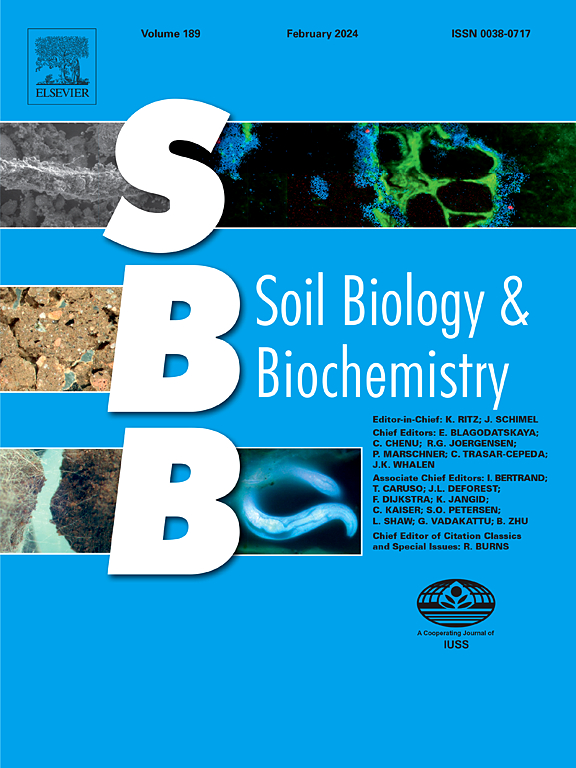施肥对土壤有机质分子组成的长期影响:碳转化是能量势的主要驱动因素
IF 10.3
1区 农林科学
Q1 SOIL SCIENCE
引用次数: 0
摘要
长期添加农家肥支持微生物碳和土壤有机质(SOM)的积累,但对能量储存的影响尚不清楚。特别是,它仍然没有解决是否粪便或微生物转化的刺激解释了增加的微生物印记。后者表明,SOM转化产物的积累控制着能量储存,而不是直接控制肥料。我们假设与原始粪便特征的重叠可以用来衡量SOM转化及其对SOM标称氧化态C (NOSC)和能势的影响ΔG0Cox。采用固体激光解吸电离傅立叶变换质谱(LDI-FT-ICR-MS)技术,研究了4个长期田间试验中粪便样品和表土的分子特征。LDI-FT-ICR-MS显示,有机肥增加了SOM的能势(0.7 - 1.2 kJ/mol C),与对照相比,有机肥增加了SOM组成的总离子丰度的3 - 16%,在长时间的田间试验中更大。与原始粪便特征无关的标记(即间接影响)解释了67 - 84%的分子变化,而与粪便直接相关的标记仅解释了2 - 12%。与未施肥土壤相比,长期施肥导致土壤有机质饱和度、氧化率和分子量增加,芳香性降低。积累的分子具有更高的能量势,尽管化学性质与原始粪便相似,但质量却有所提高,这表明粪便衍生的构建块可能用于微生物合成大分子。在施过肥料的样品中,能量势较低的分子消失了,这反映在水可萃取有机物的氧化态较高,表明SOM的溶解度增加。我们的研究结果表明,添加肥料后,土壤有机质的性质发生了统一的变化,但强调了土壤有机质组成变化的特定地点轨迹的作用。我们讨论了粪便诱导的微生物转化对SOM能量储存和长期稳定性的影响。本文章由计算机程序翻译,如有差异,请以英文原文为准。


Long-term effects of manure addition on soil organic matter molecular composition: Carbon transformation as a major driver of energetic potential
Long-term addition of farmyard manure supports the accumulation of microbial carbon (C) and soil organic matter (SOM), but the effects on energy storage remain unknown. In particular, it remains unresolved whether manure or the stimulation of microbial transformations explains the increased microbial imprint. The latter would suggest that the accumulation of SOM transformation products controls energy storage, rather than manure directly. We hypothesized that the overlap with original manure signatures could be used as a measure of SOM transformation and its effect on SOM's nominal oxidation state of C (NOSC) and energetic potential ΔG0COX. We employed solid-state laser desorption/ionization Fourier transform ion cyclotron resonance mass spectrometry (LDI-FT-ICR-MS) to study molecular signatures of manure samples and topsoil from four long-term field experiments receiving manure, and unfertilized controls. In line with bulk elemental analysis, LDI-FT-ICR-MS suggested that manure increased SOM's energetic potential (0.7–1.2 kJ/mol C). Manure addition changed SOM composition by 3–16% of total ion abundance as compared to controls, being larger in longer-running field experiments. Markers unrelated to original manure signatures (i.e., indirect effects) explained 67–84% of molecular changes while markers directly related to manure explained only 2–12%. Long-term manure addition resulted in increased saturation, oxidation and molecular weight, and decreased aromaticity of SOM as compared to unfertilized soils. Accumulated molecules had higher energetic potentials and were, despite being chemically similar to original manure, elevated in mass, suggesting potential use of manure-derived building blocks for microbial synthesis of larger molecules. Molecules with lower energetic potential disappeared in manured samples, mirrored by a higher oxidation state of water-extractable organic matter, pointing to an increased solubility of SOM. Our results indicate a uniform shift in SOM properties upon manure addition, but highlight the role of site-specific trajectories of SOM compositional change. We discuss the implications of manure-induced microbial transformations for energy storage and long-term stability of SOM.
求助全文
通过发布文献求助,成功后即可免费获取论文全文。
去求助
来源期刊

Soil Biology & Biochemistry
农林科学-土壤科学
CiteScore
16.90
自引率
9.30%
发文量
312
审稿时长
49 days
期刊介绍:
Soil Biology & Biochemistry publishes original research articles of international significance focusing on biological processes in soil and their applications to soil and environmental quality. Major topics include the ecology and biochemical processes of soil organisms, their effects on the environment, and interactions with plants. The journal also welcomes state-of-the-art reviews and discussions on contemporary research in soil biology and biochemistry.
 求助内容:
求助内容: 应助结果提醒方式:
应助结果提醒方式:


